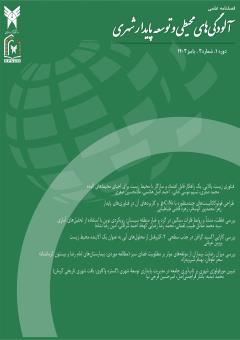تبیین مورفولوژی شهری بر تابآوری جامعه در مدیریت پایداری توسعۀ شهری (گسترۀ واکاوی: بافت شهری تاریخی کرمان)
محورهای موضوعی : محیط زیست ، اقتصاد ، مهندسی ، شهرسازی و توسعه پایدار
محمد دبدبه
1
![]() ,
یاشار قراچمنیاصل
2
,
یاشار قراچمنیاصل
2
![]() ,
امیرحسین فرحینیا
3
,
امیرحسین فرحینیا
3
![]()
1 - دانشآموختۀ دکتری، گروه معماری و شهرسازی، واحد تبریز، دانشگاه آزاد اسلامی، تبریز، ایران
2 - دانشآموختۀ دکتری معماری، واحد اصفهان (خوراسگان)، دانشگاه آزاد اسلامی، اصفهان، ایران
3 - استادیار گروه معماری و شهرسازی، دانشگاه ملی مهارت، تهران، ایران
کلید واژه:
چکیده مقاله :
گسترش فیزیکی شهر، بهویژه در شهرهایی که ویژگیهای طبیعی متمایزی دارند، بدون ساماندهی سازگار بر ساختارهای طبیعی، تاریخی و الگوهای رشد مورفولوژی شهری میتواند به شکست فرایندهای توسعۀ شهری منجر شود. شهر کرمان بهعنوان یکی از شهرهای تاریخی ایران با هویت فرهنگی بیهمتا، در برابر خسارات ناشی از توسعۀ صنعتی و مدرن مصون نمانده است. آسیبپذیریهای فیزیکی و اجتماعی بهمثابۀ توسعۀ شهری با نگاه سرمایهای و ارزشی به زمین، گسترش سبک زندگی جدید با ارزشهای خاص خود، نادیدهگرفتن ساختار طبیعی و بافت تاریخی بهعنوان یک الگوی پایدار، طراحی شهری بر پایۀ خودرو محور و همچنین پدیدۀ مهاجرت و رشد پراکندۀ رسمی و غیررسمی، شهر کرمان را بهسوی چالشهای گسترده سوق داده است. بهطور خاص پژوهش حاضر، به بررسی و ارزیابی تابآوری جامعه به روش تحقیق کمی و واکاوی عوامل مورفولوژی شهری مؤثر بر کاهش آسیبپذیری در شهرهای تاریخی از دیدگاه ساکنان پرداخته است. پرسش اصلی تحقیق بر آن است که چگونه میتوان عوامل مورفولوژی شهری را با هدف افزایش تابآوری جامعه در بافت شهری تاریخی کرمان طبقهبندی کرد؟ سنجش فرضیههای تحقیق، اطلاعات میدانی از راهبرد پیمایشی تبیین و پراکُنش در ۳۸8 پرسشنامه تدوین شده است. در تجزیه و تحلیل اطلاعات از آزمون واکاوی عاملی اکتشافی (EFA)، برای گروهبندی عوامل استفاده شد. یافتهها حاکی از آن است که رتبهبندی طرحریزی گزینههای مورفولوژی شهری در بافت تاریخی کرمان در سه دسته قابل تقسیم است: «عوامل ثابت در وضعیت کنونی»، «عوامل چالشزا»، و «عوامل بیتفاوت». عوامل چالشزا؛ محورهای فضاهای درمانی (ضریب بار ۹۳۲/0)، اندازهگیری دسترسی سواره (ضریب بار ۹۲۶/0)، پیاده (ضریب بار ۶۶۴/0)، تراکم کاربریهای پرجمعیت (ضریب بار ۹۰۵/0)، کیفیت ساختمانها (ضریب بار ۸۶۶/0)، ساختمانهای متروکه و ویران (ضریب بار ۷۸۱/0)، و محورهای فضاهای عمومی (ضریب بار ۷۲۹/0) است. این تحقیق نشان داد برنامهریزی، مدیریت اصولی و توجه به الگوهای پایدار بافت تاریخی و طبیعی شهر، کلید کاهش آسیبپذیری و افزایش تابآوری شهری در جهت توسعۀ شهری مؤثر خواهد بود.
The physical expansion of a city, when not properly aligned with its natural and historical structures, can lead to failures in urban development processes, particularly in cities with distinctive natural features. Kerman, one of Iran's historical cities with a unique cultural identity, has not been immune to the damages caused by industrial and modern development. Physical and social vulnerabilities, such as urban expansion driven by capitalist and land-centric perspectives, the spread of new lifestyles with distinct values, neglect of natural structures and historical fabric as sustainable models, car-centric urban design, and scattered migration and growth, have propelled Kerman toward extensive challenges. This study specifically examines and evaluates community resilience through quantitative research, exploring how urban morphology influences the reduction of vulnerability in historical cities from the residents' perspective. The main research question is: How can urban morphological factors be classified to increase community resilience in the historical urban fabric of Kerman? To assess the research hypotheses, field data were collected through explanatory and dispersed survey strategies, utilizing 388 questionnaires. Data analysis was conducted using Exploratory Factor Analysis (EFA) to group factors. The findings indicate that the classification of urban morphological options in Kerman's historical fabric can be divided into three categories: "Constant Factors in the Current Situation," "Challenging Factors," and "Indifferent Factors." The challenging factors include healthcare facility axes (loading factor 0.932), vehicular access (loading factor 0.926), pedestrian access (loading factor 0.664), density of populous land uses (loading factor 0.905), building quality (loading factor 0.866), abandoned and dilapidated buildings (loading factor 0.781), and public space axes (loading factor 0.729). This study demonstrates that planning, principled management, and attention to sustainable patterns within the city's historical and natural fabric are key to reducing vulnerability and increasing urban resilience for effective urban development.


